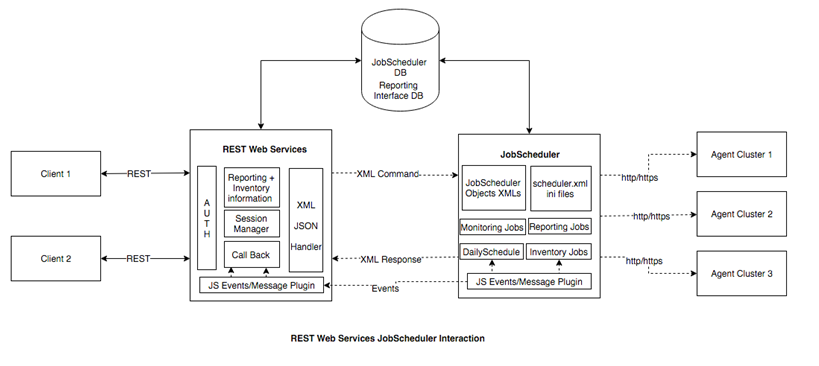Overview
The introduction of the JobScheduler Operating Center (JOC) Cockpit with the release of Version 1.11 brings a significant change in the JobScheduler architecture. As can bee seen in the diagram below, the JOC Cockpit is installed separately from a JobScheduler Master and all communication between the Cockpit and Master JobScheduler(s) takes place as an authenticated web service.
Additional features of this new architecture are:
- The JobScheduler Web Services can be accessed by more than one Cockpit, so that, for example, an operator situated in a remote site can carry routine tasks at the same time as an administrator in the server room is configuring maintenance procedures.
- The Web Services use the LDAP Directory not only for authentication but also for authorization. This means that user access to particular resources can be restricted.
- External Applications such as ERP systems can access the Web Services and, for example, start jobs when they provide the correct authentication and authorization.
- Any number of JobScheduler Masters can be controlled via the Web Services as long as they are in the same network.
- JobScheduler Universal Agents or Universal Agent Clusters cannot be directly controlled via the Web Services - this must take place via a JobScheduler Master.
- JobScheduler Masters record status and other information in a database - this information can be called up from the JOC Cockpit via the Web Services.
Technical Details
The diagram below shows the JobScheduler JOC Cockpit Architecture at a more technical level.
HTTP is used for communication between the RESTful Web Services and the JOC Cockpit - or other application - clients.
The Web Services use XML commands and responses to communicate with the JobScheduler Master(s). [Protokol??] In addition events are communicated [Protokol??] between the Web Services and the JobSchedulers.
Communication between the JobScheduler Masters and Agents takes place using HTTP/HTTPS [Genauer??] .
Communication between the REST Web Services and the JobScheduler database takes place using ?? [Genauer??] .
The Authentication and
1. Screenshots
- Dashboard
- Liste der Job-Ketten
- Darstellung einer Split/Sync Job-Kette mit graphischer Ansicht
- Daily Plan: klären für welches Datum
- Historie: Log soll sichtbar sein
- PowerPoint
- Folie Nr. 6 überarbeiten (aus Anhang)
- Info
- Nur zur Info: Knowledge Base Adresse: https://kb.sos-berlin.com/x/EgAv
- 2-3 Seiten in SOS Web Site
- Top Features
i. Dashboard
- Screenshot 1.a)
ii. Authentication and Authorization
iii. Multi-client Capability
iv. Navigation, Usability
- Screenshots aus 1.b) 1.e)
- Architektur, Technologie
i. Architecture Slide (overview)
